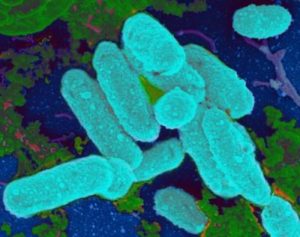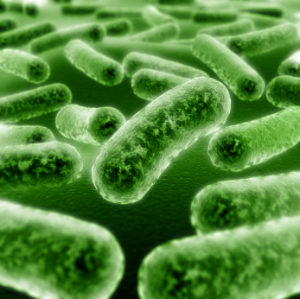A topic that is rarely mentioned is the human virome (the collection of resident viruses in the human body). We all have many viruses, but almost nothing is known about them.This is an introductory article about the human virome. From the January 11, 2014 Science News:
The microbiome — what scientists refer to as the collection of bacteria, fungi and other single-celled organisms that live in and on the body — has been a hot research topic for more than a decade. But bacteria aren’t the only microbes with which we humans share space.
The most abundant inhabitants of what many researchers are calling “the human ecosystem” are the viruses. Viruses are deceptively simple organisms consisting of genetic material packed in a protein shell. They are tiny and can’t replicate on their own, relying on human or other cells to reproduce.
And yet, scientists estimate that 10 quintillion virus particles populate the planet. That’s a one followed by 31 zeros. They outnumber bacteria 10-to-1 in most ecosystems. And they’re ubiquitous in and on humans.
Pérez-Brocal and others are learning that viruses, once seen only as foreign invaders that make people sick, are an integral part of human biology. Some cause major diseases, including influenza, AIDS and some cancers. Others, conversely, may promote health. Some may even help us gauge how well the human immune system works.
The study of people’s resident viruses, known collectively as the human virome, is “a whole new frontier in the understanding of humans,” and could become important for the future of medicine, says Forest Rohwer, an environmental microbiologist at San Diego State University.
Rohwer’s research indicates that viruses are part of the human defense system. Mucus studded with bacteria-infecting viruses called bacteriophage, or phage, may help protect host cells from invasive microbes, he and his colleagues reported June 25 in the Proceedings of the National Academy of Sciences.
“We know a lot about the bacteria that inhabit humans,” says David Pride, an infectious disease doctor at the University of California, San Diego. In comparison, “we know absolutely nothing about the viruses.” Not that scientists haven’t been interested in viruses. Until recently there was just no good way to identify them, an important first step toward understanding the biology of health and disease. As a consequence, virome research is in its infancy.
Researchers have gotten a head start on cataloging bacterial denizens of the body because all bacterial cells contain a version of the 16S ribosomal RNA gene. Virus hunters aren’t so lucky. There is no analogous virus-identification tag. Instead, to look for viruses, researchers must sequence hundreds of thousands of bits of DNA from a sample — skin swabs, saliva, feces or mucus, for example. Scientists have gotten really good at generating these DNA sequences; the trick is figuring out what they are.
Every time Frederic Bushman samples a new person’s virome, he says, he finds new viruses. A microbiologist at the University of Pennsylvania Perelman School of Medicine in Philadelphia, Bushman has shown that no two people’s gut viruses are exactly alike. But once a person has picked up a community of bacteria-infecting phage, it tends to stick around. Fully 80 percent of the viruses present when the researchers first started tracking one man’s virome were still there more than two years later.
Maybe researchers can use bacteriophage to shape the human microbiome in healthier ways. Using phage to control bacteria is a resurgence of an old idea. In the 1920s, doctors in the former Soviet Union and other Eastern European countries began using phage to treat specific bacterial infections. Unlike antibiotics, which kill bacteria indiscriminately, phage target only certain microbes for destruction.
“Healthy subjects are just loaded with viruses,” Wylie says. Even viruses known to cause diseases such as the common cold were found in healthy kids. That makes it difficult to determine whether a particular virus is really making someone sick.
Some viruses previously thought innocent may cause harm. To figure out which viruses are friends, foes or neutral passengers on the human body, scientists first need to identify them. Researchers still aren’t very good at recognizing new viruses, says Brian Jones, a molecular biologist at the University of Brighton in England.
Based on what researchers have learned so far about the virome, Jones is convinced that viruses and other microbes “should be viewed as a part of us rather than something that lives in or on us.” They are part of the puzzle, the intricate ecosystem composed of human and microbial cells, all pushing and pulling at one another and subject to local conditions, such as diet and environment.

 Even though this study was done in a laboratory, it gives further support for the treatment of sinusitis with bacteria and other microbes. And it could help explain why repeated courses of antibiotics don't "cure" many chronic infections - because biofilms filled with pathogenic bacteria are signs of microbial communities out-of-whack. Which is why my family's successful chronic sinusitis treatment with kimchi (juice) containing Lactobacillus sakei is all the more impressive. From Science Daily:
Even though this study was done in a laboratory, it gives further support for the treatment of sinusitis with bacteria and other microbes. And it could help explain why repeated courses of antibiotics don't "cure" many chronic infections - because biofilms filled with pathogenic bacteria are signs of microbial communities out-of-whack. Which is why my family's successful chronic sinusitis treatment with kimchi (juice) containing Lactobacillus sakei is all the more impressive. From Science Daily: Several people have recently written to me about kimchi and asked why I originally chose vegan kimchi over kimchi containing a seafood ingredient (typically fish or shrimp sauce) for sinusitis treatment. I have also been asked whether vegan kimchi has enough Lactobacillus sakei bacteria in it as compared to kimchi made with a seafood seasoning. (see Sinusitis Treatment Summary page and/or Sinusitis posts for in-depth discussions of Lactobacillus sakei in successful sinusitis treatment).
Several people have recently written to me about kimchi and asked why I originally chose vegan kimchi over kimchi containing a seafood ingredient (typically fish or shrimp sauce) for sinusitis treatment. I have also been asked whether vegan kimchi has enough Lactobacillus sakei bacteria in it as compared to kimchi made with a seafood seasoning. (see Sinusitis Treatment Summary page and/or Sinusitis posts for in-depth discussions of Lactobacillus sakei in successful sinusitis treatment).